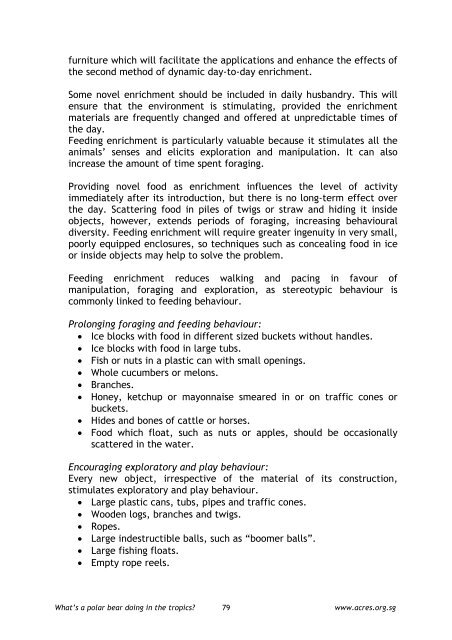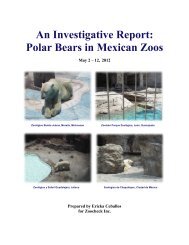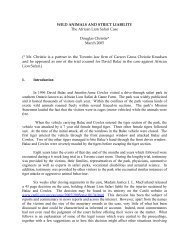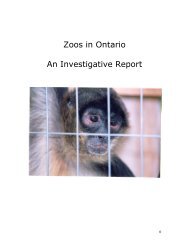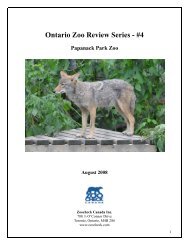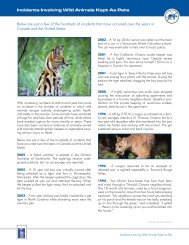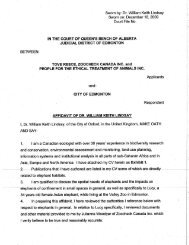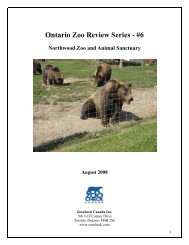What's a Polar Bear Doing in the Tropics? - Animal Concerns ...
What's a Polar Bear Doing in the Tropics? - Animal Concerns ...
What's a Polar Bear Doing in the Tropics? - Animal Concerns ...
Create successful ePaper yourself
Turn your PDF publications into a flip-book with our unique Google optimized e-Paper software.
furniture which will facilitate <strong>the</strong> applications and enhance <strong>the</strong> effects of<strong>the</strong> second method of dynamic day-to-day enrichment.Some novel enrichment should be <strong>in</strong>cluded <strong>in</strong> daily husbandry. This willensure that <strong>the</strong> environment is stimulat<strong>in</strong>g, provided <strong>the</strong> enrichmentmaterials are frequently changed and offered at unpredictable times of<strong>the</strong> day.Feed<strong>in</strong>g enrichment is particularly valuable because it stimulates all <strong>the</strong>animals’ senses and elicits exploration and manipulation. It can also<strong>in</strong>crease <strong>the</strong> amount of time spent forag<strong>in</strong>g.Provid<strong>in</strong>g novel food as enrichment <strong>in</strong>fluences <strong>the</strong> level of activityimmediately after its <strong>in</strong>troduction, but <strong>the</strong>re is no long-term effect over<strong>the</strong> day. Scatter<strong>in</strong>g food <strong>in</strong> piles of twigs or straw and hid<strong>in</strong>g it <strong>in</strong>sideobjects, however, extends periods of forag<strong>in</strong>g, <strong>in</strong>creas<strong>in</strong>g behaviouraldiversity. Feed<strong>in</strong>g enrichment will require greater <strong>in</strong>genuity <strong>in</strong> very small,poorly equipped enclosures, so techniques such as conceal<strong>in</strong>g food <strong>in</strong> iceor <strong>in</strong>side objects may help to solve <strong>the</strong> problem.Feed<strong>in</strong>g enrichment reduces walk<strong>in</strong>g and pac<strong>in</strong>g <strong>in</strong> favour ofmanipulation, forag<strong>in</strong>g and exploration, as stereotypic behaviour iscommonly l<strong>in</strong>ked to feed<strong>in</strong>g behaviour.Prolong<strong>in</strong>g forag<strong>in</strong>g and feed<strong>in</strong>g behaviour:• Ice blocks with food <strong>in</strong> different sized buckets without handles.• Ice blocks with food <strong>in</strong> large tubs.• Fish or nuts <strong>in</strong> a plastic can with small open<strong>in</strong>gs.• Whole cucumbers or melons.• Branches.• Honey, ketchup or mayonnaise smeared <strong>in</strong> or on traffic cones orbuckets.• Hides and bones of cattle or horses.• Food which float, such as nuts or apples, should be occasionallyscattered <strong>in</strong> <strong>the</strong> water.Encourag<strong>in</strong>g exploratory and play behaviour:Every new object, irrespective of <strong>the</strong> material of its construction,stimulates exploratory and play behaviour.• Large plastic cans, tubs, pipes and traffic cones.• Wooden logs, branches and twigs.• Ropes.• Large <strong>in</strong>destructible balls, such as “boomer balls”.• Large fish<strong>in</strong>g floats.• Empty rope reels.What’s a polar bear do<strong>in</strong>g <strong>in</strong> <strong>the</strong> tropics?79www.acres.org.sg


